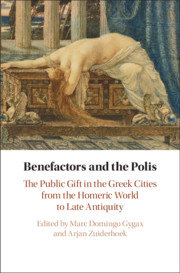 Benefactors and the Polis
Benefactors and the Polis Book contents
- Benefactors and the Polis
- Benefactors and the Polis
- Copyright page
- Contents
- Figures
- Tables
- Contributors
- Acknowledgements
- Abbreviations
- Introduction
- Part I Benefiting the Community in Early Greece
- Part II Classical Benefactors
- Part III Hellenistic Benefactors
- Chapter 5 The Politics of Endowments
- Chapter 6 ‘To be magnanimous and grateful’
- Chapter 7 Socially Embedded Benefaction on Delos
- Part IV Benefactors and the Polis under Rome
- Part V The Decline and Fall of Euergetism?
- Conclusion
- Index
- Index locorum
- References
Chapter 7 - Socially Embedded Benefaction on Delos
from Part III - Hellenistic Benefactors
Published online by Cambridge University Press: 21 January 2021
- Benefactors and the Polis
- Benefactors and the Polis
- Copyright page
- Contents
- Figures
- Tables
- Contributors
- Acknowledgements
- Abbreviations
- Introduction
- Part I Benefiting the Community in Early Greece
- Part II Classical Benefactors
- Part III Hellenistic Benefactors
- Chapter 5 The Politics of Endowments
- Chapter 6 ‘To be magnanimous and grateful’
- Chapter 7 Socially Embedded Benefaction on Delos
- Part IV Benefactors and the Polis under Rome
- Part V The Decline and Fall of Euergetism?
- Conclusion
- Index
- Index locorum
- References
Summary
This chapter considers the ‘vase festivals’ recorded on Hellenistic Delos as benefactions, and then considers the implications of this approach on our chronology for the period. It argues that the vase festival was a socially constrained form of competitive display, one open only to Delians and others who successfully sought and negotiated this privilege. Through the endowment and the associated display, these individuals claimed and performed a distinct superior status: as patrons of the sanctuary. But this was not an exclusive claim. It coexisted with and competed with other claims, both when they were founded and in subsequent years. As such, the dates and periods during which royal (and non-royal) individuals founded these vase festivals (Third Ptolemaea, 246/5 BC, Soteria/Antigonia, 245/4 BC, etc.) can be understood as periods of engagement by those individuals on Delos and the region. But this competitive context indicates that they should not be understood as dates for changes of control. Quite the reverse: if the vase festivals have any implication for our understanding of the broader geopolitical terrain – and they may not – they indicate that these were times when interest in the sanctuary and the region were higher, and when any specific patronage or hegemonic relationships in the sanctuary and the region were particularly contested.
Keywords
- Type
- Chapter
- Information
- Benefactors and the PolisThe Public Gift in the Greek Cities from the Homeric World to Late Antiquity, pp. 179 - 198Publisher: Cambridge University PressPrint publication year: 2021
